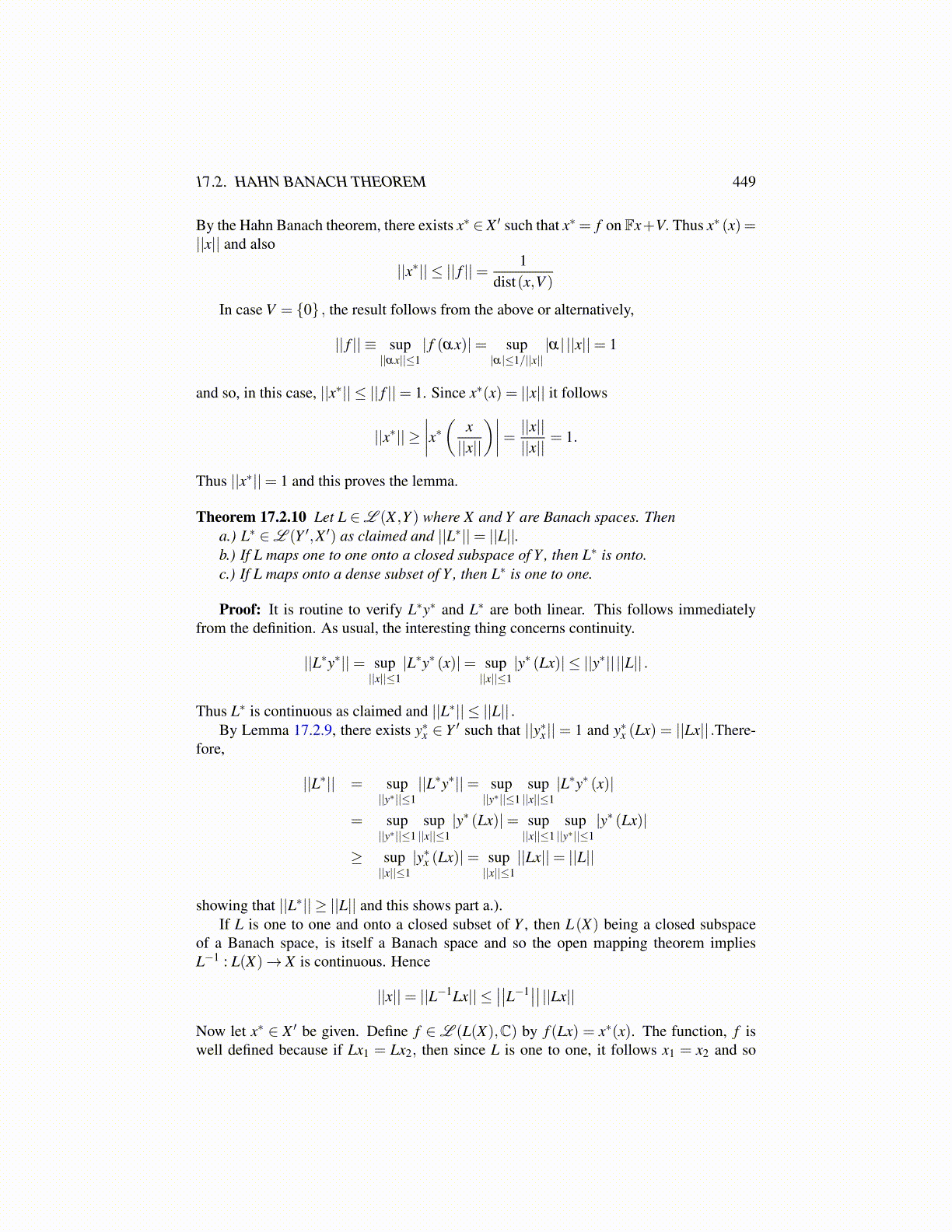
17.2. HAHN BANACH THEOREM 449
By the Hahn Banach theorem, there exists x∗ ∈ X ′ such that x∗ = f on Fx+V. Thus x∗ (x) =||x|| and also
||x∗|| ≤ || f ||= 1dist(x,V )
In case V = {0} , the result follows from the above or alternatively,
|| f || ≡ sup||αx||≤1
| f (αx)|= sup|α|≤1/||x||
|α| ||x||= 1
and so, in this case, ||x∗|| ≤ || f ||= 1. Since x∗(x) = ||x|| it follows
||x∗|| ≥∣∣∣∣x∗( x
||x||
)∣∣∣∣= ||x||||x|| = 1.
Thus ||x∗||= 1 and this proves the lemma.
Theorem 17.2.10 Let L ∈L (X ,Y ) where X and Y are Banach spaces. Thena.) L∗ ∈L (Y ′,X ′) as claimed and ||L∗||= ||L||.b.) If L maps one to one onto a closed subspace of Y , then L∗ is onto.c.) If L maps onto a dense subset of Y , then L∗ is one to one.
Proof: It is routine to verify L∗y∗ and L∗ are both linear. This follows immediatelyfrom the definition. As usual, the interesting thing concerns continuity.
||L∗y∗||= sup||x||≤1
|L∗y∗ (x)|= sup||x||≤1
|y∗ (Lx)| ≤ ||y∗|| ||L|| .
Thus L∗ is continuous as claimed and ||L∗|| ≤ ||L|| .By Lemma 17.2.9, there exists y∗x ∈ Y ′ such that ||y∗x || = 1 and y∗x (Lx) = ||Lx|| .There-
fore,
||L∗|| = sup||y∗||≤1
||L∗y∗||= sup||y∗||≤1
sup||x||≤1
|L∗y∗ (x)|
= sup||y∗||≤1
sup||x||≤1
|y∗ (Lx)|= sup||x||≤1
sup||y∗||≤1
|y∗ (Lx)|
≥ sup||x||≤1
|y∗x (Lx)|= sup||x||≤1
||Lx||= ||L||
showing that ||L∗|| ≥ ||L|| and this shows part a.).If L is one to one and onto a closed subset of Y , then L(X) being a closed subspace
of a Banach space, is itself a Banach space and so the open mapping theorem impliesL−1 : L(X)→ X is continuous. Hence
||x||= ||L−1Lx|| ≤∣∣∣∣L−1∣∣∣∣ ||Lx||
Now let x∗ ∈ X ′ be given. Define f ∈L (L(X),C) by f (Lx) = x∗(x). The function, f iswell defined because if Lx1 = Lx2, then since L is one to one, it follows x1 = x2 and so